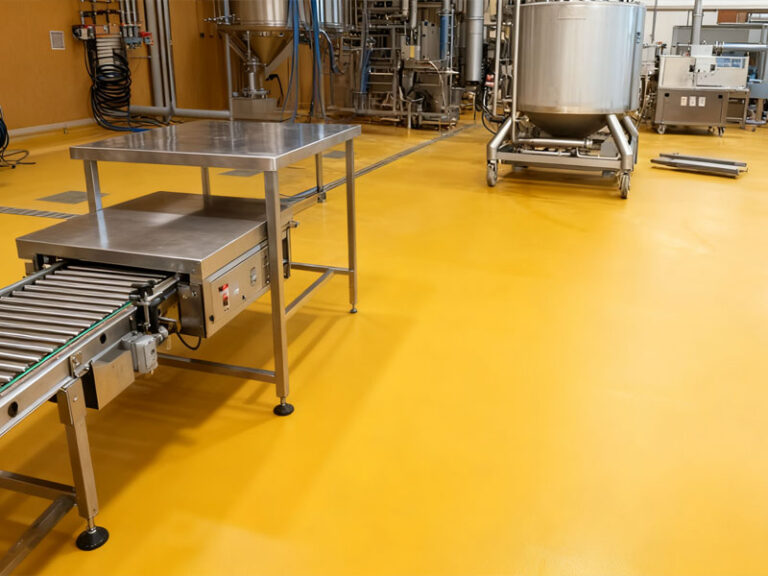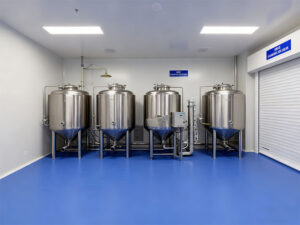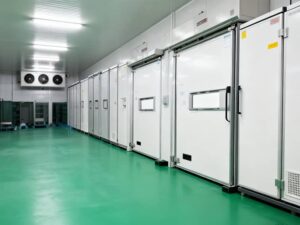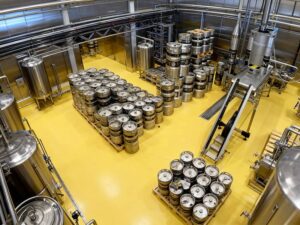For food processing plants facing demanding environments, the best polyurethane flooring for food processing plants is overwhelmingly a waterborne polyurethane mortar system. This article provides a definitive guide to selecting the right type, comparing the three main systems, and outlining a step-by-step selection process to ensure compliance, durability, and long-term value for your specific operational zones.
What is Polyurethane Flooring for Food Processing Plants?
Polyurethane flooring for food processing plants is a specialized seamless floor system designed to withstand extreme conditions like thermal shock, chemical corrosion, and heavy physical impact.
- Unlike standard industrial floors, it combines a polyurethane resin binder with graded silica aggregates to create a non-porous, joint-free surface that resists bacteria growth and is easy to clean.
- Key properties include resistance to acids (lactic, citric), caustic cleaners, and fats, as well as the ability to handle temperatures from steam cleaning to freezing storage.
- According to the National Sanitation Foundation (NSF/ANSI 14159-1), principles for the hygienic design of equipment emphasize seamless surfaces to prevent microbial harborage, a core benefit of polyurethane mortar systems.
The 3 Best Types of Polyurethane Flooring for Food Plants
Choosing the best polyurethane flooring for food processing plants requires matching the system to the specific area’s demands. The table below provides a clear comparison.
Comparing Types of Polyurethane Flooring for Food Processing
| Tipo | Espessura | Caraterísticas principais | Ideal Application Zones |
|---|---|---|---|
| Self-Leveling Polyurethane Mortar | 6-9 mm | Ultra-smooth, seamless finish; superior chemical and thermal shock resistance. | Production areas, cooking zones, beverage processing, places with frequent steam cleaning. |
| Heavy-Duty Trowel-Down Polyurethane Mortar | 9-12 mm+ | Exceptional impact resistance and load-bearing capacity; high slip resistance. | Warehouses, loading docks, areas with heavy forklift traffic. |
| Thin-Grade Polyurethane Coating | 1-3 mm | Cost-effective barrier; seamless and chemical-resistant; fast installation. | Packaging areas, dry storage, laboratories, low-traffic zones. |
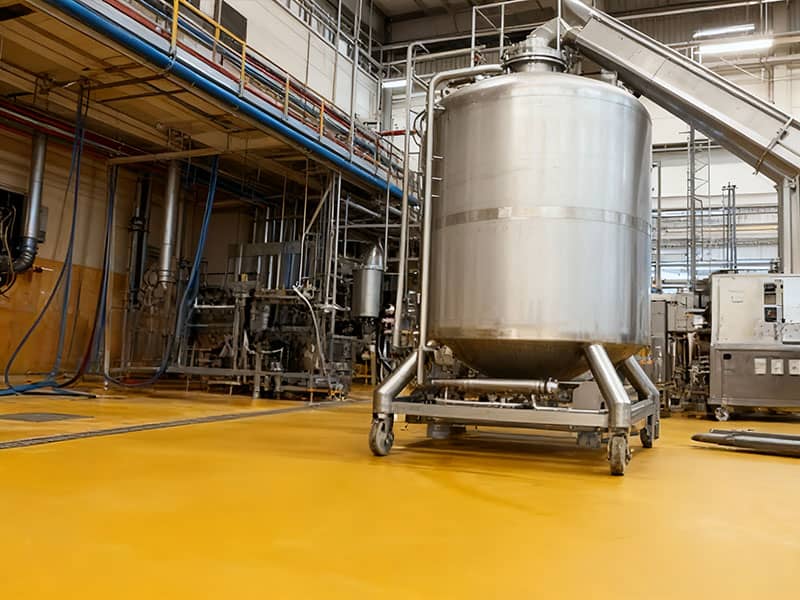
How to Choose Polyurethane Flooring for Food Processing Plants: A 4-Step Framework
Selecting the right polyurethane flooring for food processing plants is a systematic process beyond just material type.
Step 1: Analyze Zone-Specific Requirements
A one-size-fits-all approach fails in a complex food plant. Different areas have unique needs.
- High-Traffic & Impact Zones: For warehouses and loading bays with constant heavy forklift use, Heavy-Duty Polyurethane Mortar is mandatory to prevent cracking and wear.
- High-Thermal Shock & Chemical Zones: In processing and cooking areas with steam cleaning and organic acids, Self-Leveling Polyurethane Mortar is the most reliable choice.
- Light-Load & Secondary Areas: For packaging or dry storage, a Thin-Grade Polyurethane Coating offers a solid, cost-effective solution.
Step 2: Verify Critical Health and Safety Certifications
The best polyurethane flooring for food processing plants must be a verified component of your HACCP plan.
- Certifications are independent validations of a product’s safety and suitability for food environments.
- When selecting a flooring system, it is critical to verify that the products hold key industry certifications that validate their safety and hygienic integrity. Insist on materials with NSF/ANSI 61 Certification, which guarantees the system is safe for use in areas involving potable water, and HACCP International Certification, which provides independent validation that the product is designed to support a Hazard Analysis Critical Control Point (HACCP) food safety management system, ensuring it meets the rigorous hygiene standards demanded in food production environments.
- A study published in the Journal of Food Protection noted that facilities using flooring certified to meet hygienic design principles saw a significant reduction in positive pathogen swab tests from floor surfaces.
Step 3: Evaluate Installation Expertise and Project Timeline
The performance of any polyurethane flooring for food processing plants is contingent on professional installation.
- Always select contractors with proven experience in food facility projects.
- Plan for downtime by confirming full cure times with your supplier and installer to minimize production disruption.
Step 4: Calculate Total Cost of Ownership (TCO)
While the initial investment is higher, the best polyurethane flooring for food processing plants provides superior long-term value.
- A lifecycle cost analysis by Industrial Flooring Magazine demonstrated that while epoxy might have a lower initial cost, polyurethane mortar’s longevity (often Mais de 20 anos) and minimal maintenance lead to a 20-30% lower total cost of ownership over 15 years.
Perguntas frequentes (FAQ)
Q: What is the difference between epoxy and polyurethane flooring for food processing plants?
A: The primary difference is thermal shock resistance. Polyurethane flooring can withstand rapid temperature changes from steam cleaning without blistering, whereas epoxy is prone to failure under such conditions. Polyurethane also generally offers better abrasion resistance and flexibility.
Q: How long does it take to install polyurethane flooring in a food plant?
A: Installation and cure time vary by system thickness. Thin coatings may be ready for light traffic in 24-48 hours, while thick mortar systems may require 5-7 days for full cure and return to heavy service. Detailed planning with your installer is crucial.
Selecting the Best Polyurethane Flooring for Food Processing Plants
Selecting the optimal polyurethane flooring for food processing plants is a critical decision that impacts safety, compliance, and operational efficiency. By focusing on waterborne polyurethane mortar systems and meticulously applying a zonal selection process, you can ensure a durable, hygienic, and cost-effective flooring solution that will serve your facility for decades.
KAIDA PAINT – Your Partner for Food-Safe Flooring
Navigating the complexities of polyurethane flooring for food processing plants requires a partner with proven expertise and certified products. KAIDA PAINT specializes in high-performance, waterborne polyurethane mortar systems engineered to meet the extreme demands of the food and beverage industry.
Why partner with KAIDA PAINT for your flooring project?
- Certified Food-Safe Solutions: Our core polyurethane flooring systems are NSF/ANSI 61 certified and compliant with HACCP International standards, ensuring they meet rigorous global food safety requirements.
- Engineered for Extreme Conditions: KAIDA formulations deliver superior resistance to thermal shock, chemical corrosion, and mechanical abrasion, providing a longer-lasting, lower-maintenance floor.
- Technical Expertise & Support: We provide more than just product; we offer end-to-end technical partnership, from system specification and substrate evaluation to supporting a flawless installation by our network of certified applicators.
Ready to build a safer, more durable foundation for your operation?
Contact KAIDA PAINT today for a free, no-obligation technical consultation and a customized specification for your facility.
